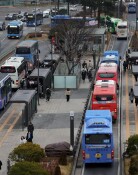Population Census Warns of Lack of Working Population
Population Census Warns of Lack of Working Population
Posted July. 10, 2003 21:50,
A study showed that each Korean woman with fertility has 1.17 child on average. Korea is also forecast to become a super-aged society by 2026, in which people aged 65 or over exceeds 20% of the total population. By 2030, 2.8 people will have to support an elderly.
On the occasion of World Population Day on July 1, the National Statistic Office (NSO) released a report yesterday on populations in Korea and the world.
Less people to win bread
Average number of children per fertile woman last year was 1.17 in Korea, smaller than 1.32 in Japan and 2.01 in the U.S.
Birth rate in Korea has also sharply reduced from 4.53 in 1970 to 1.30 in 2001, a drop by 3.23 in the past 31 years. During the same period, birth rate reduction was 0.8 in Japan, 0.7 in Germany and 0.8 in the UK.
Marriages have been postponed in the nation as well. As of last year, men married at the age of 29.8 and women 27 on average. In particular, 63.2% of women in their 20s were single as of 2000.
Decrease in birth-rate will result in the lack of working population, aged between 15 to 64. NSO estimated that the ratio of economically active population would peak at 71.7% (33.702 million) in 2000 and decline to 64.6% (32.475 million) in 2030.
Thanks to medical breakthrough, elderly population aged over 65 is expected to comprise 14.4% in 2019 and 20.0% in 2026. A nation, in which the population aged 65 and older accounts for over 14%, belongs to an aged society while a nation with the constituency over 20% is called a super-aged society.
Accordingly, social burdens will increase dramatically in 2030, when 2.8 working population should support an elderly. As of 2003, 8.6 persons support a senior.
Accelerating family collapse
Last year, divorce case recorded 3 for every 1,000 Koreans, doubled from 1995.
Each day, 398 couples divorce on average, which is a three-fold increase from 125 in 1990.
It was estimated that 70 out of 100 divorced couples have at least one child aged below 20.
The number of elderly living alone has significantly increased. The elderly living in solitude accounted for 8.9% of the total number of the aged in 1990, but the number has grown to 16.1% in 2000.
In the meantime, total population of the Republic of Korea stood at 47.93 million as of July 1 this year. When the North population added, the total population on the peninsular reached 70.45 million, ranking Korea 17th in the world. Posted at 0.6% this year, the nation`s population growth rate is expected to start declining in 2024.
World population, estimated at 6.29 billion as of July 1, 2003, is believed to grow to 7 billion by 2013, 8 billion by 2026, and to 9.3 billion by 2050. World population density is 45 persons per square kilometer: 23 in advanced nations and 59 in developing nations. Korea ranked third in population density with 481 persons living in a square kilometer.
Ki-Jeong Ko koh@donga.com







